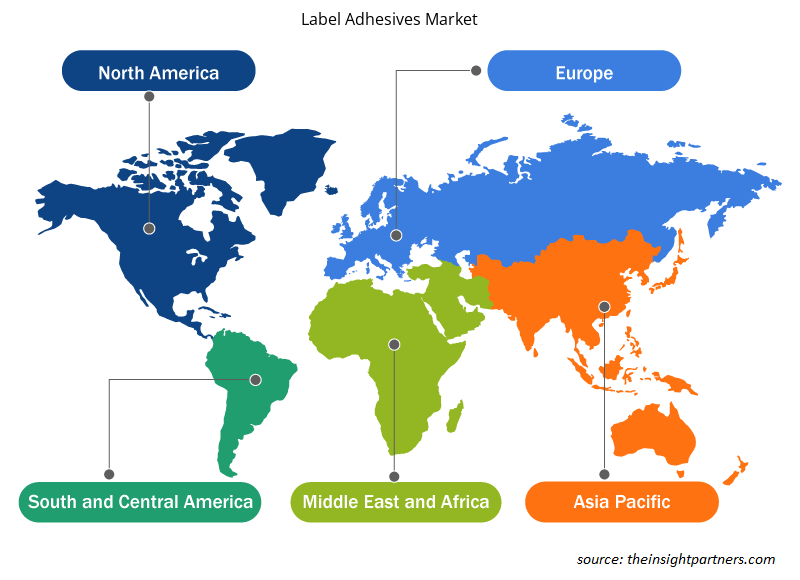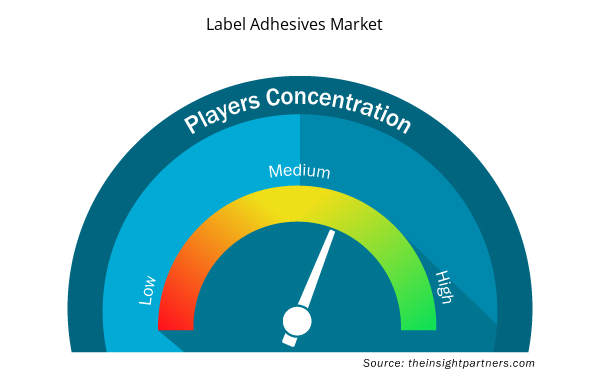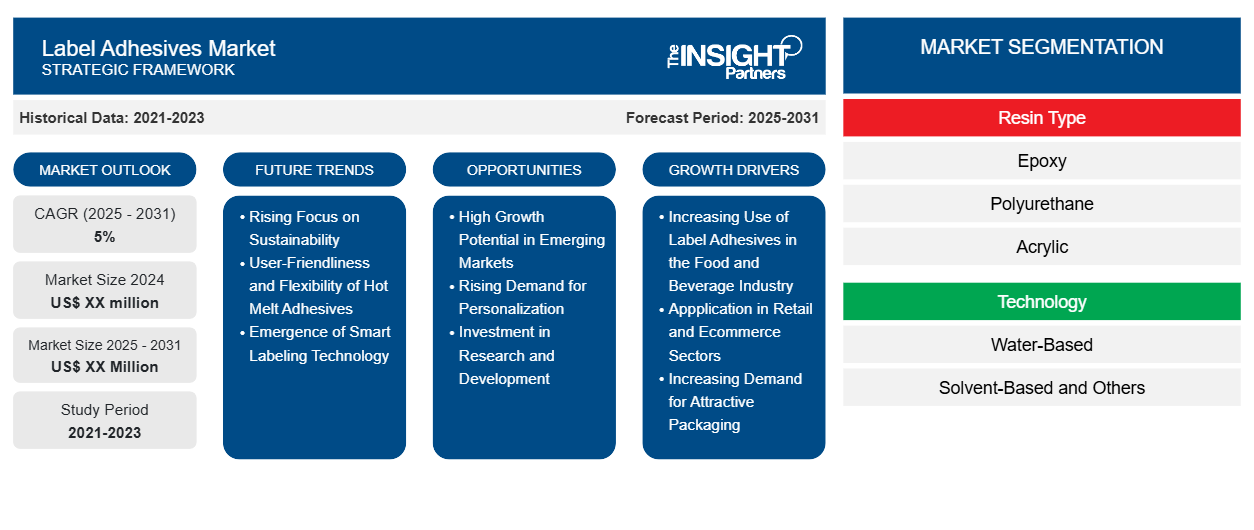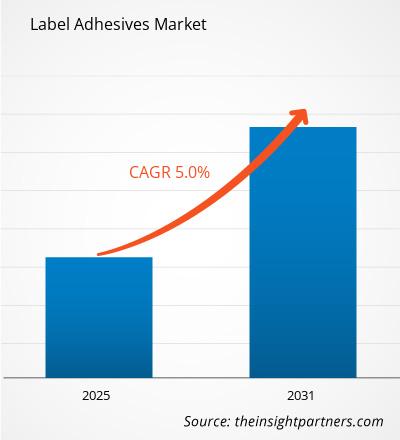Si prevede che il mercato degli adesivi per etichette registrerà un CAGR del 5% dal 2023 al 2031, con una dimensione di mercato in espansione da XX milioni di dollari nel 2023 a XX milioni di dollari entro il 2031.
Il rapporto è segmentato in base al tipo di resina (epossidica, poliuretanica, acrilica, poliammidica e altre) e alla tecnologia (a base d'acqua, a base di solvente e altre). Il rapporto presenta inoltre un'analisi basata sul settore di utilizzo finale (cibo e bevande, prodotti farmaceutici, cura della persona e cosmetici, beni di consumo, prodotti per la cura della casa e altri). L'analisi globale è ulteriormente suddivisa a livello regionale e nei principali paesi. Le dimensioni del mercato e le previsioni a livello globale, regionale e nazionale per tutti i principali segmenti di mercato sono coperte nell'ambito. Il rapporto offre il valore in USD per l'analisi e i segmenti di cui sopra. Il rapporto fornisce statistiche chiave sullo stato di mercato dei principali attori del mercato e offre tendenze e opportunità di mercato.
Scopo del rapporto
Il report Label Adhesives Market di The Insight Partners mira a descrivere il panorama attuale e la crescita futura, i principali fattori trainanti, le sfide e le opportunità. Ciò fornirà spunti a vari stakeholder aziendali, come:
- Fornitori/produttori di tecnologia: per comprendere le dinamiche di mercato in evoluzione e conoscere le potenziali opportunità di crescita, consentendo loro di prendere decisioni strategiche informate.
- Investitori: condurre un'analisi completa delle tendenze relative al tasso di crescita del mercato, alle proiezioni finanziarie del mercato e alle opportunità esistenti lungo la catena del valore.
- Enti di regolamentazione: regolamentano le politiche e le attività di controllo sul mercato allo scopo di ridurre al minimo gli abusi, preservare la fiducia degli investitori e sostenere l'integrità e la stabilità del mercato.
Segmentazione del mercato degli adesivi per etichette
Tipo di resina
- Epossidico
- Poliuretano
- Acrilico
- Poliammide e altri
Tecnologia
- A base d'acqua
- A base solvente e altri
Settore di utilizzo finale
- Cibo e bevande
- Prodotti farmaceutici
- Cura della persona e cosmetici
- Beni di consumo
- Prodotti per la cura della casa e altri
Geografia
- America del Nord
- Europa
- Asia-Pacifico
- America del Sud e Centro
- Medio Oriente e Africa
Geografia
- America del Nord
- Europa
- Asia-Pacifico
- America del Sud e Centro
- Medio Oriente e Africa
Personalizza questo report in base alle tue esigenze
Riceverai la personalizzazione gratuita di qualsiasi report, comprese parti di questo report, o analisi a livello nazionale, pacchetto dati Excel, oltre a usufruire di grandi offerte e sconti per start-up e università
- Scopri le principali tendenze di mercato in questo rapporto.Questo campione GRATUITO includerà analisi di dati che spaziano dalle tendenze di mercato alle stime e alle previsioni.
Driver di crescita del mercato degli adesivi per etichette
- Utilizzo crescente di adesivi per etichette nel settore alimentare e delle bevande: si registra un notevole aumento nell'utilizzo di adesivi per etichette nel settore alimentare e delle bevande, che può essere attribuito all'elevato consumo di prodotti alimentari confezionati e alla necessità di metodi di applicazione delle etichette efficienti. Anche i produttori di alimenti sono stati colpiti dalle preoccupazioni relative all'etichettatura alimentare, con la maggior parte di loro alla ricerca di adesivi forti, resistenti al freddo, all'umidità e all'usura generale. Le preferenze dei consumatori stanno guidando le tendenze del mercato, con la maggior parte delle aziende che desidera utilizzare adesivi approvati per il contatto con gli alimenti e sostenibili dal punto di vista ambientale per i propri materiali di imballaggio. Questo segmento in crescita continuerà probabilmente a influenzare lo sviluppo nel mercato degli adesivi per etichette.
- Applicazione nei settori della vendita al dettaglio e dell'e-commerce: il mercato degli adesivi per etichette è stato influenzato anche dal boom delle attività di e-commerce e vendita al dettaglio. Ciò è dovuto principalmente al fatto che, con l'aumento degli acquisti online, le persone avranno sempre più bisogno di soluzioni di imballaggio protettivo che migliorino la presenza del marchio. C'è una crescente domanda di adesivi per fissare le etichette su scatole, contenitori e altri dispositivi di spedizione per migliorare il servizio di consegna. Ciò consente all'azienda di consegnare il prodotto appropriato in modo efficiente all'indirizzo corretto. Inoltre, a causa dell'attenzione del mercato al dettaglio sul branding e sulla grafica, la richiesta di adesivi per etichette di migliore qualità è destinata ad aumentare.
- Domanda crescente di imballaggi accattivanti: gli imballaggi, in particolare quelli accattivanti, sono fondamentali per guidare le vendite, quindi le aziende stanno investendo molto nella progettazione degli imballaggi. Anche gli adesivi per etichette con grafica stampata svolgono un ruolo essenziale nella protezione del design e dei colori delle etichette, il che può influire sull'immagine del marchio e sulla fedeltà dei clienti. Anche la tendenza a offrire imballaggi personalizzati ed eleganti sta prendendo piede, incoraggiando i produttori a migliorare la loro tecnologia adesiva per design di etichette creative. La necessità di etichette funzionali ma accattivanti aumenterà per competere in un mercato sempre più affollato.
Tendenze future del mercato degli adesivi per etichette
- Attenzione crescente alla sostenibilità: una delle tendenze più importanti nel settore degli adesivi per etichette è la transizione verso la sostenibilità. La produzione di adesivi per etichette, ad esempio, realizzati con risorse rinnovabili e materie prime biodegradabili, è una priorità per i produttori. Le innovazioni aiutano a fornire soluzioni al pubblico di riferimento in cerca di prodotti ecocompatibili e alle relative politiche. Pertanto, si è registrato un crescente utilizzo di adesivi a base d'acqua e senza solventi per ridurre le emissioni nell'ambiente e promuovere la sostenibilità nelle soluzioni di imballaggio.
- Facilità d'uso e flessibilità degli adesivi hot melt: gli adesivi hot melt stanno guadagnando molta popolarità anche nel mercato degli adesivi per etichette grazie alla loro facilità d'uso e flessibilità. Nelle ultime tecnologie degli adesivi hot melt sono state introdotte nuove formulazioni che facilitano la loro efficienza di legame anche in condizioni difficili e su substrati difficili. Questi adesivi offrono tempi di polimerizzazione rapidi, quindi adatti ad ambienti con produzione ad alta velocità. I miglioramenti tecnologici riguardanti gli adesivi hot melt miglioreranno le soluzioni di etichettatura e potrebbero influenzare il mercato a favore dei produttori.
- Emersione della tecnologia di etichettatura intelligente: l'emergere della tecnologia di etichettatura intelligente offre una prospettiva completamente nuova al mercato degli adesivi per etichette. C'è una crescente applicazione di tecnologie come codici QR, tag NFC e RFID, che crea una domanda di colle con proprietà migliorate che svolgono funzioni specifiche in vari ambienti. Tali soluzioni portano tecnologie all'imballaggio dei beni e consentono ai marchi di comunicare con i propri consumatori e fornire alcune informazioni sul prodotto in un formato elettronico. Questo sviluppo consente ai produttori di adesivi di creare una nuova gamma di prodotti basata sui requisiti dei sistemi di etichettatura intelligenti.
Opportunità di mercato per gli adesivi per etichette
- Elevato potenziale di crescita nei mercati emergenti: esiste il potenziale per etichettare i produttori di adesivi nei mercati emergenti, poiché l'industrializzazione e la spesa dei consumatori in quei paesi stanno crescendo. I paesi dell'Asia Pacifica, dell'America Latina e dell'Africa sono tutti in modalità di crescita, soprattutto nei settori manifatturiero e della vendita al dettaglio; quindi, sono necessarie soluzioni di etichettatura. Personalizzando i loro prodotti per adattarli alle offerte e alle preferenze del mercato locale, le aziende possono puntare a penetrare questi mercati.
- Domanda crescente di personalizzazione: la domanda crescente di soluzioni di etichettatura personalizzate è una tendenza emergente nel mercato degli adesivi per etichette. Sempre più aziende desiderano etichette che si distinguano dalle altre per promuovere ulteriormente i propri marchi fino all'ultimo consumatore. I produttori possono sfruttare questa tendenza creando adesivi che consentono stampe sofisticate che possono includere diversi tipi di materiali e design molto elaborati. Progettare prodotti adesivi che consentano modifiche può essere una strategia che le aziende possono applicare per soddisfare particolari esigenze dei clienti.
- Investimenti in ricerca e sviluppo: l'attività di ricerca e sviluppo dovrebbe essere supportata nel mercato degli adesivi per etichette per promuovere cambiamenti progressivi. Le aziende possono cercare nuovi tipi di formulazioni, nuovi tipi di materiali e nuove tecnologie di adesione ecocompatibili e performanti. Una R&S mirata allo sviluppo di adesivi con maggiore forza di legame, migliore resistenza termica e compatibilità con diversi substrati aiuterà i produttori a occupare le prime posizioni di mercato. Anche collaborare con organizzazioni di ricerca esterne per ridurre il time-to-market per innovazioni e nuovi prodotti può essere utile.
Approfondimenti regionali sul mercato degli adesivi per etichette
Le tendenze regionali e i fattori che influenzano il mercato degli adesivi per etichette durante il periodo di previsione sono stati ampiamente spiegati dagli analisti di Insight Partners. Questa sezione discute anche i segmenti e la geografia del mercato degli adesivi per etichette in Nord America, Europa, Asia Pacifico, Medio Oriente e Africa e Sud e Centro America.

- Ottieni i dati specifici regionali per il mercato degli adesivi per etichette
Ambito del rapporto di mercato sugli adesivi per etichette
| Attributo del report | Dettagli |
|---|---|
| Dimensioni del mercato nel 2023 | XX milioni di dollari USA |
| Dimensioni del mercato entro il 2031 | XX milioni di dollari USA |
| CAGR globale (2023-2031) | 5% |
| Dati storici | 2021-2022 |
| Periodo di previsione | 2024-2031 |
| Segmenti coperti | Per tipo di resina
|
| Regioni e Paesi coperti | America del Nord
|
| Leader di mercato e profili aziendali chiave |
|
Densità degli attori del mercato degli adesivi per etichette: comprendere il suo impatto sulle dinamiche aziendali
Il mercato degli adesivi per etichette sta crescendo rapidamente, spinto dalla crescente domanda degli utenti finali dovuta a fattori quali l'evoluzione delle preferenze dei consumatori, i progressi tecnologici e una maggiore consapevolezza dei vantaggi del prodotto. Con l'aumento della domanda, le aziende stanno ampliando le loro offerte, innovando per soddisfare le esigenze dei consumatori e capitalizzando sulle tendenze emergenti, il che alimenta ulteriormente la crescita del mercato.
La densità degli operatori di mercato si riferisce alla distribuzione di aziende o società che operano in un particolare mercato o settore. Indica quanti concorrenti (operatori di mercato) sono presenti in un dato spazio di mercato in relazione alle sue dimensioni o al valore di mercato totale.
Le principali aziende che operano nel mercato degli adesivi per etichette sono:
- Società quotata in borsa Ashland Global Holdings Inc.
- Avery Denison
- BOSTIK SA
- Società chimica DOW
- Etichette di galateo Ltd.
Disclaimer : le aziende elencate sopra non sono classificate secondo un ordine particolare.

- Ottieni una panoramica dei principali attori del mercato degli adesivi per etichette
Punti di forza chiave
- Copertura completa: il rapporto copre in modo completo l'analisi di prodotti, servizi, tipologie e utenti finali del mercato degli adesivi per etichette, fornendo una panoramica olistica.
- Analisi degli esperti: il rapporto è compilato sulla base della conoscenza approfondita di esperti e analisti del settore.
- Informazioni aggiornate: il rapporto garantisce la pertinenza aziendale grazie alla copertura di informazioni recenti e tendenze nei dati.
- Opzioni di personalizzazione: questo report può essere personalizzato per soddisfare le esigenze specifiche del cliente e adattarsi in modo appropriato alle strategie aziendali.
Il rapporto di ricerca sul mercato degli adesivi per etichette può quindi aiutare a guidare il percorso di decodifica e comprensione dello scenario del settore e delle prospettive di crescita. Sebbene possano esserci alcune preoccupazioni valide, i vantaggi complessivi di questo rapporto tendono a superare gli svantaggi.
- Analisi storica (2 anni), anno base, previsione (7 anni) con CAGR
- Analisi PEST e SWOT
- Valore/volume delle dimensioni del mercato - Globale, regionale, nazionale
- Industria e panorama competitivo
- Set di dati Excel


- Electronic Toll Collection System Market
- Fish Protein Hydrolysate Market
- Neurovascular Devices Market
- Rare Neurological Disease Treatment Market
- Machine Condition Monitoring Market
- Ceramic Injection Molding Market
- Wire Harness Market
- Microplate Reader Market
- Sweet Potato Market
- Hydrogen Compressors Market

Report Coverage
Revenue forecast, Company Analysis, Industry landscape, Growth factors, and Trends

Segment Covered
This text is related
to segments covered.

Regional Scope
North America, Europe, Asia Pacific, Middle East & Africa, South & Central America

Country Scope
This text is related
to country scope.
Domande frequenti
Based on geography, North America held the significant share of the label adhesives market due to growth in the food and beverage and pharmaceuticals sector
Growing demand of eco-friendly adhesives is expected to be the key market trends
Based on end-use industry, consumer goods segment is expected to witness the fastest growth during the forecast period
The Label Adhesives Market is estimated to witness a CAGR of 5% from 2023 to 2031
Growing demand in the food and beverage sector is driving the market growth
Avery Dennison Corporation; Bostik; Dow; H.B. Fuller Company; HERMA GmbH are some of the key players operating in the label adhesives market
Trends and growth analysis reports related to Chemicals and Materials : READ MORE..
The List of Companies
- Ashland Global Holdings Inc.
- Avery Denision
- BOSTIK S.A
- DOW Chemical Company
- Etiquette Labels Ltd.
- H.B. Fuller
- Herma
- Intelligent Label Solutions
- Lintec Corporation
- Pacific Adhesives
The Insight Partners performs research in 4 major stages: Data Collection & Secondary Research, Primary Research, Data Analysis and Data Triangulation & Final Review.
- Data Collection and Secondary Research:
As a market research and consulting firm operating from a decade, we have published and advised several client across the globe. First step for any study will start with an assessment of currently available data and insights from existing reports. Further, historical and current market information is collected from Investor Presentations, Annual Reports, SEC Filings, etc., and other information related to company’s performance and market positioning are gathered from Paid Databases (Factiva, Hoovers, and Reuters) and various other publications available in public domain.
Several associations trade associates, technical forums, institutes, societies and organization are accessed to gain technical as well as market related insights through their publications such as research papers, blogs and press releases related to the studies are referred to get cues about the market. Further, white papers, journals, magazines, and other news articles published in last 3 years are scrutinized and analyzed to understand the current market trends.
- Primary Research:
The primarily interview analysis comprise of data obtained from industry participants interview and answers to survey questions gathered by in-house primary team.
For primary research, interviews are conducted with industry experts/CEOs/Marketing Managers/VPs/Subject Matter Experts from both demand and supply side to get a 360-degree view of the market. The primary team conducts several interviews based on the complexity of the markets to understand the various market trends and dynamics which makes research more credible and precise.
A typical research interview fulfils the following functions:
- Provides first-hand information on the market size, market trends, growth trends, competitive landscape, and outlook
- Validates and strengthens in-house secondary research findings
- Develops the analysis team’s expertise and market understanding
Primary research involves email interactions and telephone interviews for each market, category, segment, and sub-segment across geographies. The participants who typically take part in such a process include, but are not limited to:
- Industry participants: VPs, business development managers, market intelligence managers and national sales managers
- Outside experts: Valuation experts, research analysts and key opinion leaders specializing in the electronics and semiconductor industry.
Below is the breakup of our primary respondents by company, designation, and region:

Once we receive the confirmation from primary research sources or primary respondents, we finalize the base year market estimation and forecast the data as per the macroeconomic and microeconomic factors assessed during data collection.
- Data Analysis:
Once data is validated through both secondary as well as primary respondents, we finalize the market estimations by hypothesis formulation and factor analysis at regional and country level.
- Macro-Economic Factor Analysis:
We analyse macroeconomic indicators such the gross domestic product (GDP), increase in the demand for goods and services across industries, technological advancement, regional economic growth, governmental policies, the influence of COVID-19, PEST analysis, and other aspects. This analysis aids in setting benchmarks for various nations/regions and approximating market splits. Additionally, the general trend of the aforementioned components aid in determining the market's development possibilities.
- Country Level Data:
Various factors that are especially aligned to the country are taken into account to determine the market size for a certain area and country, including the presence of vendors, such as headquarters and offices, the country's GDP, demand patterns, and industry growth. To comprehend the market dynamics for the nation, a number of growth variables, inhibitors, application areas, and current market trends are researched. The aforementioned elements aid in determining the country's overall market's growth potential.
- Company Profile:
The “Table of Contents” is formulated by listing and analyzing more than 25 - 30 companies operating in the market ecosystem across geographies. However, we profile only 10 companies as a standard practice in our syndicate reports. These 10 companies comprise leading, emerging, and regional players. Nonetheless, our analysis is not restricted to the 10 listed companies, we also analyze other companies present in the market to develop a holistic view and understand the prevailing trends. The “Company Profiles” section in the report covers key facts, business description, products & services, financial information, SWOT analysis, and key developments. The financial information presented is extracted from the annual reports and official documents of the publicly listed companies. Upon collecting the information for the sections of respective companies, we verify them via various primary sources and then compile the data in respective company profiles. The company level information helps us in deriving the base number as well as in forecasting the market size.
- Developing Base Number:
Aggregation of sales statistics (2020-2022) and macro-economic factor, and other secondary and primary research insights are utilized to arrive at base number and related market shares for 2022. The data gaps are identified in this step and relevant market data is analyzed, collected from paid primary interviews or databases. On finalizing the base year market size, forecasts are developed on the basis of macro-economic, industry and market growth factors and company level analysis.
- Data Triangulation and Final Review:
The market findings and base year market size calculations are validated from supply as well as demand side. Demand side validations are based on macro-economic factor analysis and benchmarks for respective regions and countries. In case of supply side validations, revenues of major companies are estimated (in case not available) based on industry benchmark, approximate number of employees, product portfolio, and primary interviews revenues are gathered. Further revenue from target product/service segment is assessed to avoid overshooting of market statistics. In case of heavy deviations between supply and demand side values, all thes steps are repeated to achieve synchronization.
We follow an iterative model, wherein we share our research findings with Subject Matter Experts (SME’s) and Key Opinion Leaders (KOLs) until consensus view of the market is not formulated – this model negates any drastic deviation in the opinions of experts. Only validated and universally acceptable research findings are quoted in our reports.
We have important check points that we use to validate our research findings – which we call – data triangulation, where we validate the information, we generate from secondary sources with primary interviews and then we re-validate with our internal data bases and Subject matter experts. This comprehensive model enables us to deliver high quality, reliable data in shortest possible time.


 Ottieni un campione gratuito per questo repot
Ottieni un campione gratuito per questo repot